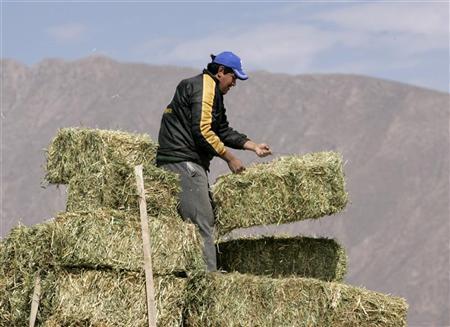Alfalfa is a forage native to the Middle East and Central Asia used primarily for dairy and beef animals. It is the fourth largest crop in the U.S. by area harvested after corn, soybeans and wheat with over 20 million acres and the third largest in value after corn and soybeans. About 40 percent of alfalfa fields have only alfalfa, mostly used by dairy farms because of the high protein content. The other fields are a mixture of alfalfa and various grasses. Alfalfa is predominately cross-pollinated in seed fields and done entirely by bees because it is not cross-pollinated by wind.
According to the EIS, the Animal and Plant Inspection Service (APHIS) of USDA is charged with “protecting American agriculture” and its Biotechnology Regulatory Service uses a science-based regulatory framework for the safe use of biotech products. In 2004 APHIS received a petition from Monsanto and Forage Genetics International (FGI) for non-regulated status (allowing the sale and use) for two alfalfa lines, known as J101 and J163, tolerant to glyphosate, a widely used herbicide. That petition was granted in June of 2005 and 200,000 acres of biotech alfalfa were planted before the 2007 court ruling that allowed the planted alfalfa to remain in use, but no additional planting after March 30, 2007.
APHIS has a narrow role under the regulations to determine if the glyphosate tolerant (GT) alfalfa is a greater plant pest risk than non-biotech alfalfa varieties. USDA has chosen to take on the additional task of promoting the coexistence of non-biotech conventional crops, organic (non-biotech) production and biotech crops in response to comments on an earlier draft EIS. The use of glyphosate herbicide is not at issue because it is regulated by EPA.
The EIS clearly states the conclusion related to the regulatory role of APHIS, “The GT alfalfa gene product is not expected to adversely affect plants and animals, including threatened and endangered species.” Based on that finding, APHIS has determined that deregulation meets the requirements of the regulations and is a preferred alternative. There would be non-regulatory restrictions including managing hay to prevent seed production, harvesting at or before ten percent bloom in areas where seed is produced, and no use in wildlife feed plots. FGI predicts that about half the alfalfa acres would eventually be planted to GT alfalfa.
The second preferred alternative is deregulation with programs that support coexistence of agricultural practices through a combination of restrictions on hay and seed production and best management practices, isolation distances, and geographic restrictions. This would be achieved by deregulating in part or through a federal government/industry partnership arrangement. Monsanto and FGI would ensure that end users follow the required management practices through contracts, licenses, or other means. Included in the EIS are specific management practices: GT alfalfa forage fields not be harvested for seed, unique GT alfalfa seed bag labeling and seed identification, development of education and training programs and an annual report on Monsanto and FGI activities submitted to USDA.
States would be divided into tiers based on the amount of seed grown. According to data used in the EIS, 27 states would be in Tier I, mostly in the Northeast, Southeast and Midwest, with no commercial alfalfa seed production and no restrictions on GT alfalfa production. Tier II would have 14 states, mostly in the upper Midwest and Plains, which produce less than one percent of U.S. seed. GT alfalfa within 165 ft of a seed field would be harvested at or before ten percent bloom. Tier III states, Arizona, California, Idaho, Montana, Nevada, Oregon, Utah, Washington, and Wyoming, produce more than 1 percent of U.S. seed. GT alfalfa would not be grown in counties were alfalfa seed is grown. All GT growers would be required to provide GPS coordinates of fields to supervising programs and seed certifying agencies. GT alfalfa seed production would be limited to Tier II and III states with an isolation distance of 5 miles from conventional alfalfa. Locations would be identified by GPS and included in the annual report to USDA. The distances for separation are generally consistent with the Association of Official Seed Certifying Agencies Alfalfa Seed Stewardship Program as described in the EIS.
Based on data used in the EIS, in 2005, the latest year available, 0.92 percent of the alfalfa used for hay was organic, up from 0.51 percent in 2000, with 72 percent of the acreage located in six states, Idaho, Wisconsin, Minnesota, North Dakota, South Dakota, and California. APHIS could not locate data on U.S. organic alfalfa seed production. Conventionally produced alfalfa for the export market also was an issue in the EIS. About 1.3 percent of alfalfa hay production is exported, with most of it exported out of California and Washington ports and over two-thirds of the shipments going to Japan. The preference in Japan is for non-biotech alfalfa, but J101 and J163 alfalfa has been approved for use by the government.
APHIS has raised significant concerns about coexistence issues, but they already seem to be addressed. As noted earlier, state government seed agencies and non-profit state seed improvement groups through the Association of Official Seed Certifying Agencies have established procedures on distance and geographic restrictions. Alfalfa seed production occurs almost exclusively in specific areas of the Western U.S. on 100 to 120 thousand acres. Seed companies of the National Alfalfa and Forage Alliance have developed best management practices for Roundup Ready (glyphosate tolerant) alfalfa seed production and coexistence of organic seed and hay production. Given the limited and regional coexistence issues and state government agencies and private groups already involved, there is no need for the isolation distances and geographic restrictions alternative.

